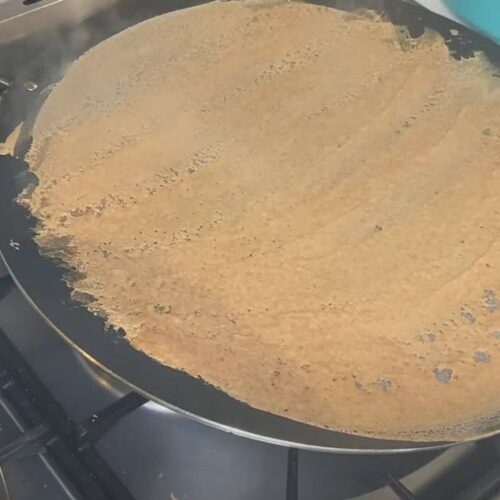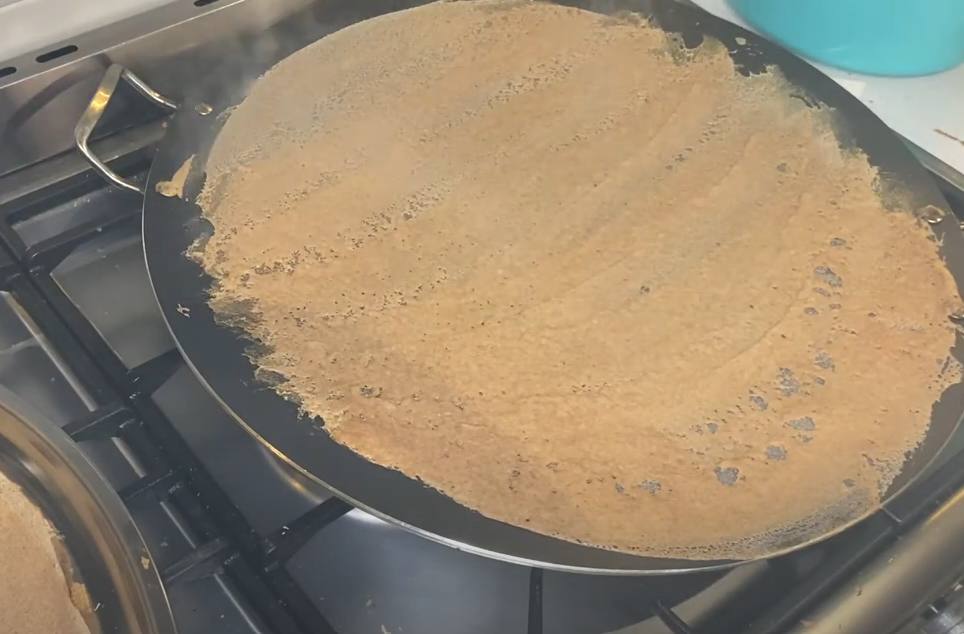Kisra is a fermented flat sorghum and wheat flour bread popular in South Sudan, Sudan, and Chad. You can enjoy kisra with any stew or sauce of your choice. If you’re looking to try it, you’ll need sorghum and wheat flour, water, and oil.
Local women in Chad and South Sudan use cow’s brain as oil because it’s naturally thick and fatty. Interestingly, some women use credit cards as a spreader because they don’t have the iron-flat tool the locals use to spread the kisra in the flat pan.
Become an insider. Subscribe to our newsletter for more top trending stories like this!
Here’s a step-by-step process of making kisra.
People Also Read: Recipe: The Fluffy Algerian Baghrir Pancake Delight
How to Make Kisra the Authentic Way
Ingredients
- 2 cups of Water
- Pam Butter Oil spray
- 1 cup of Sorghum flour
- A cup of Unrefined or plain wheat flour
Instructions
- Pour the flour together and mix. Add some water bit by bit and mix until you get a consistent mixture without lumps.
- Don’t add too much water to make the mixture watery.
- Cover the kisra mixture with a plastic cover and leave it for a day or two. Don’t put it in the fridge, but leave it in the kitchen to ferment or become sour.
- Spay a small amount of oil or dip a paper towel in oil and rub it on the electric crepe or flat crepe.
- Pour a bit of the sorghum mix at the far end in a moon shape using a scoop and spread in a circular shape using the Garigariba (flat spoon) or spreader.
- Wait for the kisra to rise; this will take about a minute.
- Don’t turn the kisra to the opposite side to cook; only cook on one side.
- Take it off the pan using a flat tool to raise the ends.
- Clean the pan with a tissue, spray some oil, and repeat the process until all the kisra is done.
- Fold them into desirable shapes and serve with any sauce of your choice.
Tips for Making Kisra
- Use unrefined wheat flour instead of refined flour for a healthy lifestyle
- You can use yellow corn flour in place of sorghum flour
- You can also get your oil spray at Amazon or use an oil sprayer
- Another option is to add yogurt to the wheat and sorghum flour mixture.
People Also Read: Recipe: Shaiyah (Sudanese Pan Fried Meat) & Salata Tomatim Bel Daqua
Video credit: Asedo’s Kitchen
Become an insider. Subscribe to our newsletter for more top trending stories like this!
Asedo grew up with three cultures from three countries. She’s a home cook and loves cooking and experimenting with different cuisines. Her channel focuses mainly on Sudanese, South Sudanese, and Kenyan recipes.

Chad’s Kisra
Equipment
Ingredients
- 2 cups of Water
- Pam Butter Oil spray
- 1 cup of Sorghum flour
- A cup of Unrefined or plain wheat flour
Instructions
- Pour the flour together and mix. Add some water bit by bit and mix until you get a consistent mixture without lumps.
- Don’t add too much water to make the mixture watery.
- Cover the kisra mixture with a plastic cover and leave it for a day or two. Don’t put it in the fridge, but leave it in the kitchen to ferment or become sour.
- Spay a small amount of oil or dip a paper towel in oil and rub it on the electric crepe or flat crepe.
- Pour a bit of the sorghum mix at the far end in a moon shape using a scoop and spread in a circular shape using the Garigariba (flat spoon) or spreader.
- Wait for the kisra to rise; this will take about a minute.
- Don’t turn the kisra to the opposite side to cook; only cook on one side.
- Take it off the pan using a flat tool to raise the ends.
- Clean the pan with a tissue, spray some oil, and repeat the process until all the kisra is done.
- Fold them into desirable shapes and serve with any sauce of your choice.
Video
Nutrition

Nearly 80% of consumers visit directories with reviews to find a local business. List your business for free in our exclusive Spotcovery Black-Owned Business Directory.
Spotcovery offers unique and fresh daily content on Black culture, lifestyle, and experiences. We talk about everything black, black people, black-owned and black-owned businesses. We also deliver authentic and relevant content that will inform, inspire, and empower you! The future of black media is critical to today’s black experience! Our primary audience includes African Americans, Africans, Afro-Caribbean, and people of African heritage. Black culture is for the culture!
Become an insider. Subscribe to our newsletter for more top trending stories like this!





